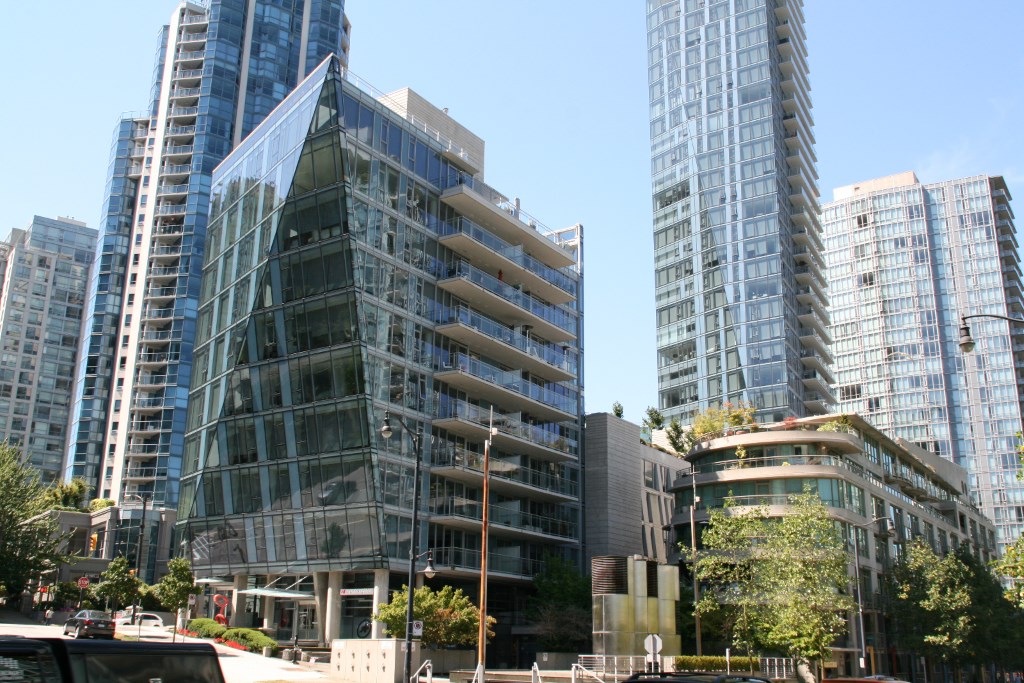The Lyft Bus, NIMBYs, and More
All the city news you can use.

West Pender Place (the glass condominium buildings) and Dockside, a condominium development that looks like a boat in Vancouver, B. C. Photo by Jeramey Jannene.
Every day at The Direct Transfer we sort through over 1,500 news items about cities and share the best ones with our email list. At the end of the week we take some of the most popular stories and share them with Urban Milwaukee readers. They are national links, sometimes entertaining and sometimes absurd, but hopefully useful.
How to overcome NIMBYism: Vox’s David Roberts sat down with former Vancouver, B. C. planner Brent Toderian to talk about density, the natural discomfort with change, and how to get past staunch opposition. NIMBYs aren’t the problem, Brent says. The problem is politicians that wimp out when they have a hard call to make but face a vocal minority. (Vox). Read more.
We can cut congestion by showing transportation’s true costs: The costs of getting from Point A to Point B are often hidden. When we drive a car, we don’t always think about how much it will cost to change the oil, pay the bridge toll, park, or purchase the car outright. If we were to show people how much it cost to take different modes of travel, it might be a route to less congestion on the roads. (Sidewalk Labs). Read more.
Silicon Valley tries to reinvent the bus: Lyft has created a new service called Shuttle that picks people up at predetermined points and drops them off at another predetermined point on a route. I believe that’s what we call… a bus. Joking aside, there are serious equity concerns with creating new services that offer something that already exists, just without the people who can’t use phones and credit cards for rides. (New York Magazine). Read more.
Downzoning won’t make land cheaper: There is a belief in some circles that downzoning (mandating that it’s only for low density development) property will make housing cheaper. But downzoning doesn’t lower demand for housing in an area, it just reduces the value of the individual properties (there by limiting its possibilities) while demand and prices rise elsewhere. (City Observatory). Read more.
London’s mayor wants to ban new parking: London Mayor Sadiq Khan wants to reduce auto trips by three million per day in order to reduce already ridiculous levels of pollution in the city. To do this, the mayor will set a target for 80% of trips to be on public transport while banning new parking in development near transit and setting up pay per mile pricing. (The Guardian). Read more.
Quote of the Week
Branden was a thoughtful, intelligent writer who challenged us to make the city better. He loved his hometown but saw ways it could be improved, and his writing went beyond criticism to offering specific ideas for improvement. His voice, his ideas and his vision will live beyond the short time he was with us.
-Louisville Mayor Greg Fischer on the passing of Brandon Klayko, who wrote the local urbanist blog Broken Sidewalk.
Sign-Up for More
Enjoy these links? Sign up for a free trial of The Direct Transfer Daily now and get 30 news items in your inbox each morning!
Urban Reads
-
Congestion Pricing Cuts Air Pollution in New York City
 Dec 14th, 2025 by Jeff Wood
Dec 14th, 2025 by Jeff Wood
-
We Think We Love to Drive. But Do We Really?
 Dec 7th, 2025 by Jeff Wood
Dec 7th, 2025 by Jeff Wood
-
Can Scott Wiener Tackle America’s Housing Crisis?
 Nov 23rd, 2025 by Jeff Wood
Nov 23rd, 2025 by Jeff Wood






















“Joking aside, there are serious equity concerns with creating new services that offer something that already exists, just without the people who can’t use phones and credit cards for rides.”
…which is why Lyft Shuttle, despite the limited level of coverage during its beta-testing period, is explicitly *not* intended to replace existing forms of public transit. Rather, it’s ultimately intended to offer both “last-mile” service — intra-neighborhood pickups in areas with no nearby transit stops — on top of providing rides to the broad swath of America where there’s quite literally no public transit, period. In the southern half of the U.S. in particular — meaning coast-to-coast, not “the South” — over HALF of its population fits the latter descriptor.
Further, Lyft Shuttle is primarily intended to reduce the number of single-occupant vehicles on American roads, which comprise over 90% of the cars on the road during rush-hour periods and represent the single-biggest causal factor with respect to traffic. In effect, Lyft Shuttle intended to become a transit solution for commuters, and a single shuttle van can remove up to a dozen cars off the road — and Lyft has enough “big data” stored by now to know which commuters both live and work in reasonable proximity to one another to prevent the shuttles from having to make many stops (in either direction) outside of a limited geographical area.
Jeff Kirk, you say Lyft Shuttle is intended to serve “areas with no nearby transit stops”.
But then why in Chicago are many of its stops right on bus routes, and why are ALL of its stops within walking distance of a bus route?
Please identify even one Lyft Shuttle stop in Chicago that is beyond walking distance (more than 1/4 mile) from a CTA bus route.